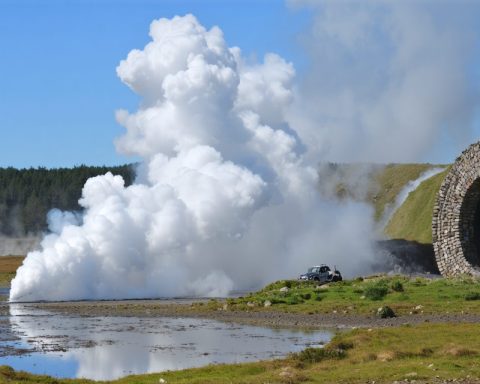- Vast reserves of natural hydrogen may exist beneath the Pyrenees, Alps, and Himalayas, holding promise for renewable energy production.
- The natural process of serpentinization allows deep mantle rocks to release hydrogen when interacting with water.
- Mountain ranges could contain up to 20 times more hydrogen than previous estimates in tectonic rift zones.
- Research led by the GFZ Helmholtz Centre for Geosciences identifies optimal conditions in mountain ranges for abundant hydrogen production.
- Exploratory studies point to the Pyrenees, Alps, and Balkans as potential sites for “white hydrogen” extraction.
- Harnessing this natural hydrogen resource offers a path to significant reductions in carbon emissions and a move away from fossil fuels.
Beneath the towering peaks of the Pyrenees, the Alps, and the Himalayas, a hidden treasure may lie—vast reserves of natural hydrogen, elegantly produced by the Earth itself. Imagine a world where the mighty mountain ranges fuel clean, renewable energy, curbing our reliance on fossil fuels and drastically cutting carbon emissions.
Recent revelations shed light on how these monumental structures could hold the key to a sustainable energy future, thanks to a fascinating natural process called serpentinization. Here, deep mantle rocks interact with water, not only forming new minerals but also releasing abundant hydrogen gas. Dragons’ hoards of hydrogen, long assumed to be the provenance of tectonic rift zones, might actually be nestled in the folds and crags of mountainscapes, ready to reshape the energy landscape.
Research spearheaded by the GFZ Helmholtz Centre for Geosciences proposes that the conditions present in mountain ranges are optimal for producing quantities of hydrogen far exceeding previous expectations. Utilizing advanced tectonic modeling, scientists have located pockets where Earth’s deep crust gives birth to this precious gas, potentially hiding up to 20 times more than found in traditional rift settings.
Early exploration hints at the Pyrenees, Alps, and Balkans as promising candidates for hydrogen harvest, sparking intensive scientific excitement. If harnessed, this “white hydrogen” could lay the cornerstone of a new energy era, edging us closer to a carbon-free society. Unlike fossil fuels, endlessly locked within the Earth for millennia, hydrogen blooms continuously through nature’s alchemy, offering a constantly replenishing resource.
As researchers dig deeper, the whisper of a hydrogen revolution grows louder, painting a vision where mountains, long-standing sentinels of time, pivot to become harbingers of a clean energy future.
Unlocking the Mountains: A New Source of Renewable Energy?
How-To Steps & Life Hacks
For countries or organizations interested in exploring and harnessing this natural hydrogen, the following steps could be insightful:
1. Identify Potential Sites: Use geological surveys and advanced tectonic modeling to identify mountain regions with the right conditions for serpentinization.
2. Partner with Research Institutions: Collaborate with institutions like the GFZ Helmholtz Centre for Geosciences to access expertise and technology in analyzing these potential sites.
3. Conduct Small-Scale Drilling: Test drilling in identified locations to verify hydrogen presence and assess extraction feasibility.
4. Develop Infrastructure: If successful, invest in the necessary infrastructure for hydrogen extraction and transportation.
Real-World Use Cases
The potential of mountain-generated hydrogen can be transformative in various sectors:
– Energy Production: Hydrogen can be used in fuel cells to produce electricity for both residential and industrial applications.
– Transportation: Hydrogen fuel cells can power eco-friendly vehicles, reducing our reliance on gasoline and diesel.
– Industrial Applications: Hydrogen is used in refineries, chemical production, and metal treatment, offering a cleaner alternative to current processes.
Market Forecasts & Industry Trends
According to a Grand View Research report, the global hydrogen generation market is expected to reach USD 315.79 billion by 2027, growing at a CAGR of 4.32%. This growth is driven by increasing government regulations toward reducing carbon emissions and governmental policies promoting clean fuel usage.
Reviews & Comparisons
When compared to traditional hydrogen production methods like natural gas reforming, “white hydrogen” from mountains presents an environmentally appealing alternative due to its low environmental impact. However, this method’s efficiency, scalability, and cost-effectiveness still require investigation.
Controversies & Limitations
While the prospects are promising, there are limitations and concerns:
– Economic Viability: The cost of extraction and infrastructure development is currently unknown and may be high.
– Environmental Impact: Large-scale extraction could potentially disrupt mountain ecosystems.
Features, Specs & Pricing
As of now, there is no standardized pricing or specifications for naturally derived hydrogen, as it’s still in exploratory phases. The focus remains on assessing its feasibility rather than commercial metrics.
Security & Sustainability
The extraction of hydrogen from mountains promotes sustainability due to its renewable nature. However, ensuring security in terms of production stability and ecological balance is crucial.
Insights & Predictions
Experts predict that natural hydrogen extraction, if proved viable, could start having a significant impact in the next 15-20 years. The gradual shift could contribute to a carbon-neutral economy by 2050.
Tutorials & Compatibility
Currently, there is limited accessibility to tutorials for hydrogen extraction from mountains as it remains a nascent science. However, compatibility with current hydrogen usage technologies is expected, as hydrogen’s properties are consistent regardless of its source.
Pros & Cons Overview
Pros
– Renewable and continuous production.
– Clean energy source with no carbon emissions.
– Potentially large reserves in mountain ranges.
Cons
– High initial exploration and infrastructure costs.
– Limited knowledge of extraction impacts.
– Potential environmental disruption.
Actionable Recommendations
1. Engage in Research: Stay informed about the latest developments in natural hydrogen research.
2. Advocate for Investment: Encourage investment in exploratory projects that could demonstrate viability.
3. Sustainability Focus: Ensure that any hydrogen projects prioritize environmental protection.
For more information on the potential of hydrogen in the energy sector, visit the International Energy Agency website.
















